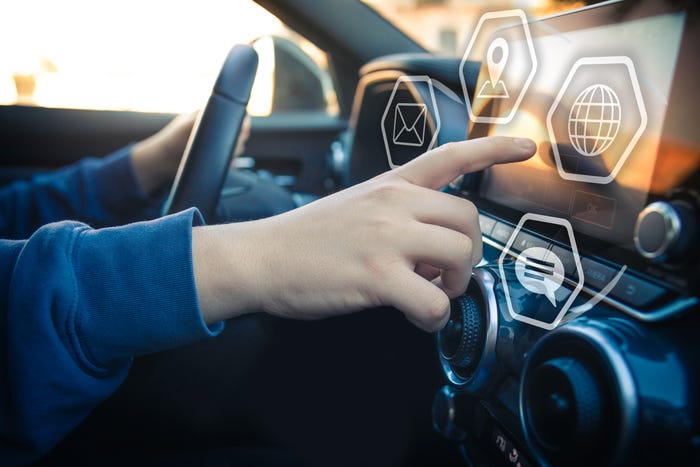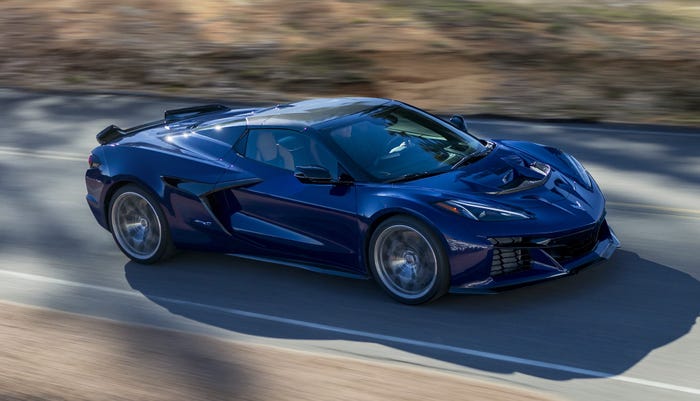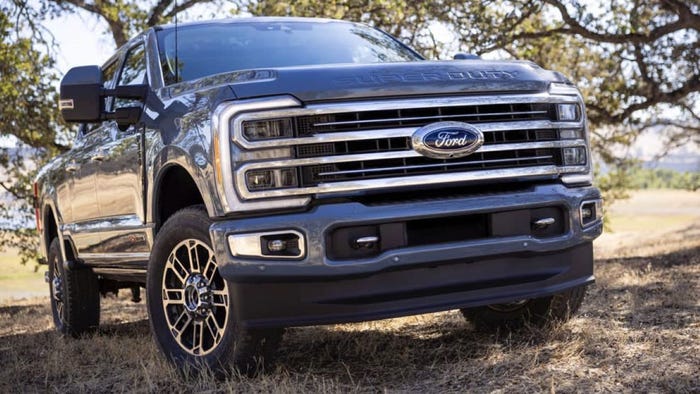EV Enthusiasm Needs Recharging - You might say we've been jolted back toreality
We've been told, in not so many words, that EVs will be the savior of the 21st century, a virtual modern-day Messiah. Maybe we shouldn't be so ready to accept on blind faith.We've been told that in the battle to preserve the environment, all conscientious Americans should willingly want to trade in their trusty internal combustion engines for clean, quiet-running electric vehicles (EVs). A proliferation
March 1, 1998

We've been told, in not so many words, that EVs will be the savior of the 21st century, a virtual modern-day Messiah. Maybe we shouldn't be so ready to accept on blind faith.
We've been told that in the battle to preserve the environment, all conscientious Americans should willingly want to trade in their trusty internal combustion engines for clean, quiet-running electric vehicles (EVs). A proliferation of EVs on our streets not only will help give our children cleaner air to breathe, but also will ease our dependence on foreign oil.
This inevitable proliferation has hovered on the horizon, just around the bend or simply over the next hill for nigh on a decade now, and we're no closer to entering the golden Age of EVs today than when we began.
That's a bold statement, and one not many environmentalists like to hear. But the reality is that the pursuit of EVs certainly looks a lot more like a dog chasing his tail. Not only are mandated, carved-in-stone quotas being postponed, but every milestone "breakthrough" in EV technology seems to amount to nothing more than eking another mile of driving range out of a multimillion-dollar experiment in energy storage.
The reason is simple: Here at the tail end of what we chronicle as the second millennium, when automotive technology seems to evolve at breakneck speed, battery development simply has failed to keep pace. And the list of excuses reads like a truant's practiced alibi: They've failed to catch on because they're still too heavy, or they can't hold enough juice, or they run too hot, or the dog ate my homework.
Automakers insist that major strides have been made in EV technology development. Development of advanced nickel-metal-hydride (NiMH) batteries has doubled the driving range capability of today's EV. And younger, more sophisticated battery technologies currently being pursued promise to extend that range even further. Nissan Motor Co. Ltd.'s Altra EV, which debuted at the Los Angeles auto show in January, features lithium-ion batteries, arguably the most technologically advanced battery medium available today. But the Altra EV boasts a combined city/highway driving range of only 120 miles (193 km).
No matter how many threats the California Air Resources Board (CARB) leveled at OEMs to meet its quotas, it was still forced to drop its 1998 deadline requiring 2% of vehicle sales in the state be EVs. The lack of significant battery development forced CARB's hand, not the insistent protests of OEMs.
The next stage of CARB's agenda requires 10% of California vehicle sales by 2003 to be EVs. Most likely, automakers will take a step or two closer, technologically. Even a leap. But at what cost?
A spokesman for General Motors Corp.'s Advanced Technology Vehicles estimates that since 1990, the No. 1 automaker has invested between $400- and $500-million in the development of the EV1 and related EV technologies.
Taxpayers have invested undisclosed millions as well. The investigation of alternative technologies using tax money, however, demands that prudent choices be made regarding the future feasibility of those developing technologies.
Until recently, lead-acid batteries - similar to the type found powering the accessories of every vehicle on the road today - have dominated the market for EV power supplies. GM's Chevrolet S-10 Electric and EV1 and Ford Motor Co.'s Electric Ranger, all of which are currently available, and Chrysler Corp.'s soon-to-be-released EPIC electric minivan, use lead-acid batteries. Although each has plans to offer NiMH battery packs, Honda Motor Co. Ltd.'s purpose-built EV Plus and Toyota Motor Corp.'s RAV4-EV skipped the lead-acid path to offer NiMH standard from the get-go.
NiMH is not new technology. In a vehicle application, it's simply a more powerful version of batteries currently powering laptops, cellular telephones and portable video recorders. And it has the advantage of better performance in colder climates than many other energy storage media.
On the other hand, NiMH batteries cost more - significantly more - than lead-acid, even on a production-quantity basis. The exact figure is difficult to nail down, but Robert C. Purcell Jr., executive director of General Motors' Advanced Technology Vehicles, estimates the NiMH package - to be offered this fall in the second-generation of the EV1 - initially will cost as much as the entire first-generation EV1.
But a spokesperson for the U.S. Advanced Battery Consortium (USABC) admits, "If someone were to produce at a rate of 10,000 to 20,000 today, they're currently at 50% over cost (based on our mid-term criteria)." USABC has established a mid-term criterion of no more than $150/kWh.
All of this still begs the question: Is this type of investment worth it? Even if a typical NiMH battery pack cost $1/kWh, few would be willing to give up the luxury of a 250-plus mile (400 km) driving range and the quick refueling time offered by a conventional passenger vehicle. And fewer still could justify the investment into this technology over other, potentially more feasible alternative-fuel vehicles.
The EV1, for example, advertises a lead-acid driving range of 70 miles (113 km) in the city, with a recharge time of two to three hours. NiMH, available in the EV1 this fall, will double that driving range to 140 miles (225 km), and double that recharge time, too, according to GM.
A Saturn retailer in California describes the EV1 as a perfect car for someone who commutes around town for only short distances but admits that "A lot of people have been scared away from it because of the driving range." And while he has only glowing things to say about its driving performance - as do most who have driven one - he understands the vehicle is a novelty right now. He likens it to a "toy for the wealthy."
"If we take the steps now to provide full support to accelerate commercialization," explains USABC Chairman Bob Davis, "market forces will take over and eliminate the need for additional government support in the future." Questionable, however, is how large a group of people you can get who match the criteria for EV use and ownership.
The cost issue should not be overlooked, but neither should the importance of reducing consumption of fossil fuels. A report issued in August 1996, by the Committee for the National Institute for the Environment (CNIE) says the U.S. consumes 17.7 million bpd (barrels per day) of oil, of which approximately 8 million bpd is imported and 11 million bpd goes directly toward fueling the transportation sector. Overall, oil provides about 40% of U.S. energy needs.
This dependence on fossil fuel undeniably impacts the environment tremendously. But by CNIE's own admission, it's clear "that gasoline and diesel fuel, through extensive reformulation, coupled with some vehicle hardware changes, probably would be able to meet the (Clean Air Act) standards and be as economical or more economical than the alternative fuels and associated vehicle changes."
Perhaps EVs are not the solution for cleaning the air and reducing our appetite for oil. Perhaps the best application of EVs should remain niche segments. Some of these niches already show signs of avid, realistic interest, as is the case of neighborhood electric vehicles (NEVs).
NEVs target smaller, residential areas such as retirement communities or planned-housing developments. With the anticipated retirement of baby boomers and their move en masse into such communities, many already recognize the attractiveness of NEVs. They provide a service with sophistication that golf carts currently fulfill only adequately.
For example, Bombardier Motor Corp. is marketing its Bombardier NEV, a vehicle capable of transporting two people at speeds up to 25 mph (40 km/h) and featuring a composite body, steel subframe and protection from the elements.
Understandably, to abandon faith in EVs seems, on some level, sacrilegious. After all, when baby boomers were saving their milk money to buy Flash Gordon comics in the '50s and '60s, it was generally accepted that the advent of the third millennium would herald such space-age developments as the flying car - only we're just now realizing it won't.
A former chairman and CEO of General Motors Corp. who had a key role in engineering the catalytic converter of 1975 and the front-wheel-drive Oldsmobile Toronado of 1966 turned his thumbs down at the company's early attempt to produce an electric car.
Today, Robert C. Stempel may be the world's biggest booster of electric automotive power - a subject that has consistently inflated and deflated over the last three decades and more.
"I was terribly disappointed in the 1980 and 1981 Electrovette with the small-car Chevette body," Mr. Stempel, who headed GM from 1990 to 1992, recalls. "I was not only upset about the battery, but it was electro-mechanical, a switch gear. We had sparks. It was jerky. I was pretty well convinced it was a technology that was clean but not going any place."
As chairman and executive director of Energy Conversion Devices Inc. (ECD) in Troy MI, he eyes what he hopes will be a multi-million dollar market for electric vehicles with his company's nickel-metal-hydride (NiMH) battery. Equally enthusiastic is the inventor of the NiMH battery, Stanley Ovshinsky, who formed Ovonic Battery in 1982 as a subsidiary of ECD to develop what many believe is the ultimate answer to a worry-free range for the electric car.
There isn't a motorist alive who has not been aware of the range limitation of maybe 40 to 70 miles (64 to 112 km) for a potential electric car. Mr. Stempel says all that has changed with electric vehicles (EVs) now running 170 miles (272 km) on a single charge. He has a strong ally: GM. GM Ovonics, a partnership, was established in 1994 to produce the NiMH battery.
What convinced Mr. Stempel of the future of EVs was the sun-powered Australian race of 2000 miles (3,219 km) in 1987. "We kept the batteries charged with solar panels on the GM Sunraycer," he says. "The efficiency was very high because we had solid state electronics and computer controls. We were able to manage every ounce of energy in the battery."
Mr. Stempel says that solid state electronics are what makes the outlook bright. "Frankly, we had very little if any progress for a hundred years," he comments. "The EV breakthrough arrived in this decade of the '90's. The NiMH battery pack in GM's EV1 has the BTU energy of a gallon of gasoline, or goes 160 miles (256 km) on what amounts to the equivalent of the energy of a gallon of gasoline."
EV1 has been running on the old lead- acid batteries, but the entire fleet will be operating with NiMH batteries by the third quarter of this year. GM Ovonics is gearing up battery production, which under U.S. Department of Transportation orders has to be made available to the entire motor vehicle industry. First recipients will be GM, Ford Motor Co. and Chrysler Corp. as members of the United States Advanced Battery Consortium. Foreign manufacturers later will be offered the batteries.
Some 30 Chevrolet S-10 pickups already have the Ovonics battery. The trucks have been bought by utilities such as Detroit Edison and Southern California Edison. "Power companies obviously are enthused about our project because they believe these vehicles in the hands of the general public can be charged during off-peak hours," Mr. Stempel says. "The power is available. We are trying to work with the utilities to lease the battery to motorists with a monthly fee that can be added to your home electric bill.
"Remember that this is a different kind of vehicle and we have to determine the best way to involve the utilities," he adds.
What's best about EVs is that they are totally emission free. California has retained its requirement that 10% of vehicles sold there in 2003 must meet zero pollution standards. Mr. Stempel estimates a thousand EVs are running around California.
The infrastructure for servicing the electrics away from their home base is a major issue. He says some of the major food chains, movie theaters and strip malls have installed chargers. Walmart has them between San Diego and Los Angeles. Southern Cal Edison installs a charger in the home owner's garage within 24 hours after the EV is delivered.
Petroleum companies, of course, are the main detractors, but even that picture is changing. Mr. Stempel explains: "Retailers for major companies are adding convenience stores with everything from firewood to hot meals-to-go.
"Their profit isn't at the pump but in the convenience store. If the customer has an electric car and goes across the street where McDonald's has a charger, the gas station is going to lose a customer. There are at least two major petroleum companies whose new business units are looking at dispensing gasoline, diesel, natural gas, propane and, yes, electricity.
"Their marketing people are having a fit, but the new businesspeople are saying, 'We are selling energy because we want those people with four wheels to come in and shop'."
ECD has more batteries on hand than cars waiting for installation. ECD or its licensees make millions of NiMH batteries of all sizes, as small as C or D. The company also is involved in solar home heating. A number of homes in not-so-sun-drenched Michigan rely on ECD solar roof panels for year-round comfort.
Mr. Stempel says the big vehicle issue is not range, but cost: He says the goal for every EV battery is $150 per kilowatt hour (kWh) of capacity. "In the 160- to 180-mile (256 to 288 km) range, you will have about 30 kW of energy. So, $150 times 30 is $4,500. When we complete the next phase of battery development, we expect to have decent volume," he says.
For comparison, "About 100,000 miles (160,000 km) of driving at 20 miles to the gallon (11.8 L/100 km) at a dollar a gallon adds up to about $5,000," says Mr. Stempel. "We think it is very cost-effective. And the Ovonics battery lasts the life of the car."
Most Americans will begin by driving hybrids, but Mr. Stempel says there are plenty of hard-core EV fans out there. There's no need for any special driving instruction except for the quietness. Motorists will have to be wary of pedestrians to the front and the rear who will not be able to hear the EV.
The public still may doubt electrics, but Mr. Stempel thinks an old foe is a supporter. Former Chrysler Chairman Lee Iacocca has announced an electric bike venture. "If anyone can prime the public pump, he can," Mr. Stempel observes.
About the Author(s)
You May Also Like
_(2).jpg?width=700&auto=webp&quality=80&disable=upscale)


